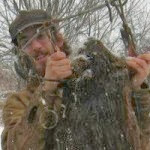Joel Salatin writes......
Daniel is our outdoorsman. He taps the yard trees for maple syrup. He's been doing this now for several years. He takes the maple sap and boils it down.
We try to encourage them to scrounge, but the other thing is that we make sure they have the tools to do the things they need to do. Nothing is as frustrating to me as to be in the situation where the 30-year-old son is working for a 55-year old dad, and the 30-year-old son has to ask Dad if he can use a board.
We've got to let those kids bend over some nails! Take that prime board we were saving for a project and rip it up! The value in those children is giving them tools for things, letting them experiment and be creative, and channel their energies and their creative gifts and talents. It'll come back a million times more the value of those bent nails and those unsquare corners and those boards they took off the board pile.
We went and had a nice pan made out of steel. Daniel got book and read out how to do this, and made a couple gallons of maple syrup. Instead of selling the maple syrup for $35 a gallon (chip off the old block) he said, How can I make this more valuable? So that's what he does. He makes maple syrup donuts, and sells about $600 worth of donuts out of those 2 gallons of maple syrup at the farmer's market in the spring.
He also does a rabbit project. This year he'll produce about a thousand rabbits at $8 apiece. It's not a bad project for a 16-year-old. We home school, so he has time to pursue these interests instead of being locked up behind some academic desk all day. This allows him time to be creative and tap into those opportunities.
He designed these hare pens himself. These are floorless pens we put out on the pasture. One acre of grass put through rabbits is worth $4500 a year. Who says you got to have a lot of land to make money farming?
He got a hold of an old magazine article about what folk people used to do when they had rabbits before Purina and all these feed store pellets came along. Turns out that what they used to feed rabbits was mangels--kind of a sugar beet. So next thing he did was find some seed, planted some, and he now supplements the rabbits with mangels. His goal is to actually get to where he feeds mangels all through the winter to supplement his grass and his pasture. He's cut his feed bill in the wintertime--as long as the mangels last--by 85 percent. It also makes a healthier, better rabbit, so everybody wins. So the rabbits are his enterprise, his deal.
One of the best things we can do when we talk about diversifying is to free this next generation up to pursue some of their own interests. One of the worst things we can do is lock the next generation into doing exactly what we're doing.
Let them have their own enterprises they own. I had my first layers when I was ten years old. Dad didn't know anything about laying chickens.
I don't know anything about rabbits. So if somebody wants to know something about rabbits, I don't try to answer their questions. I say there's the guru right there, ask him. You cannot imagine what it does to the self-esteem and self-worth and the creativity and the enthusiasm of a young person to be the resident expert when they are ten or eleven years old.
This is from the article
Diversifying for profit, pleasure, and production. Click and enjoy.



